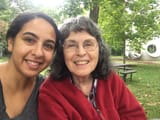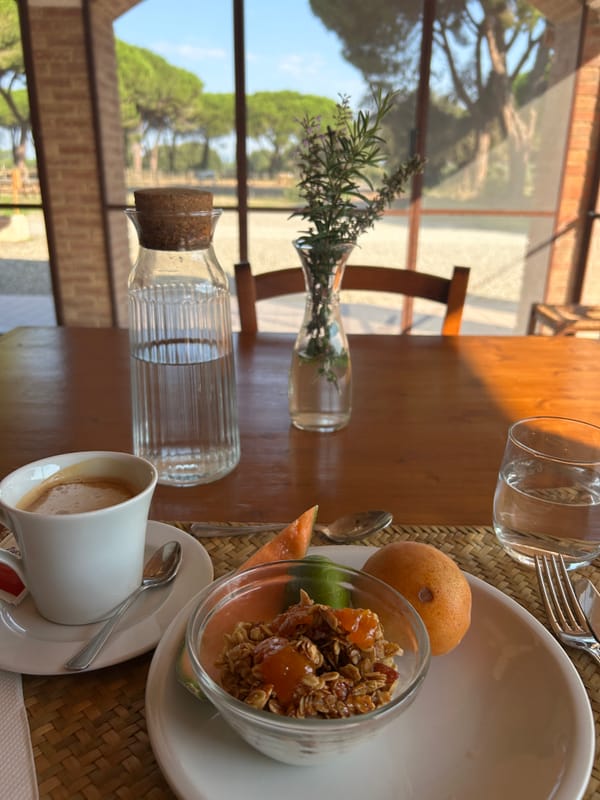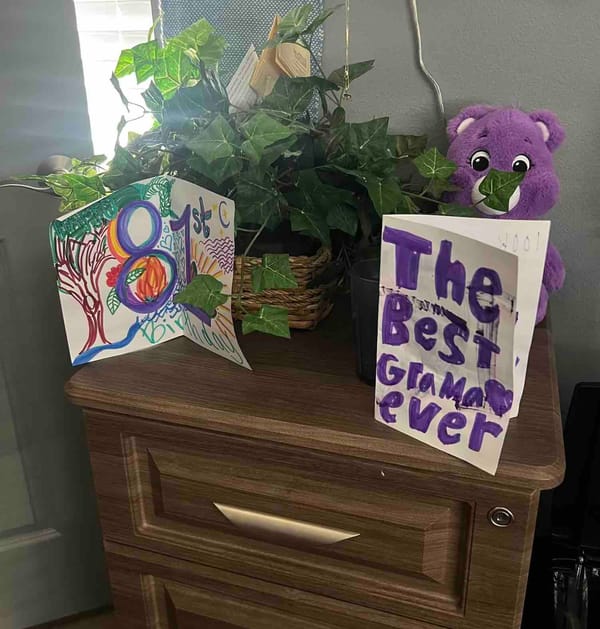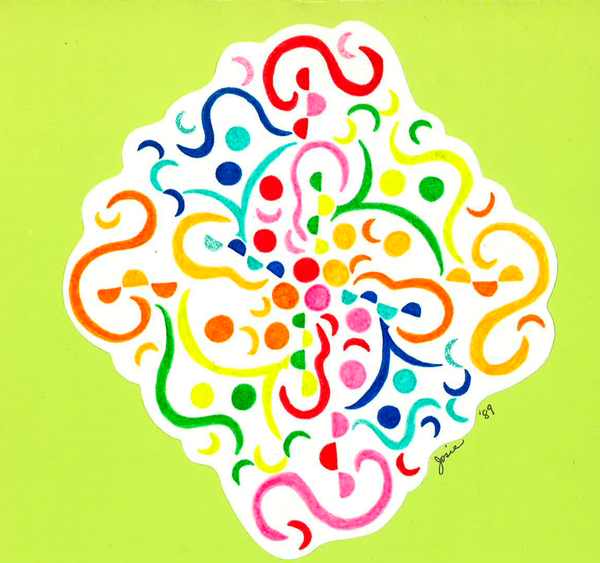The Cottage and The Blue Couch
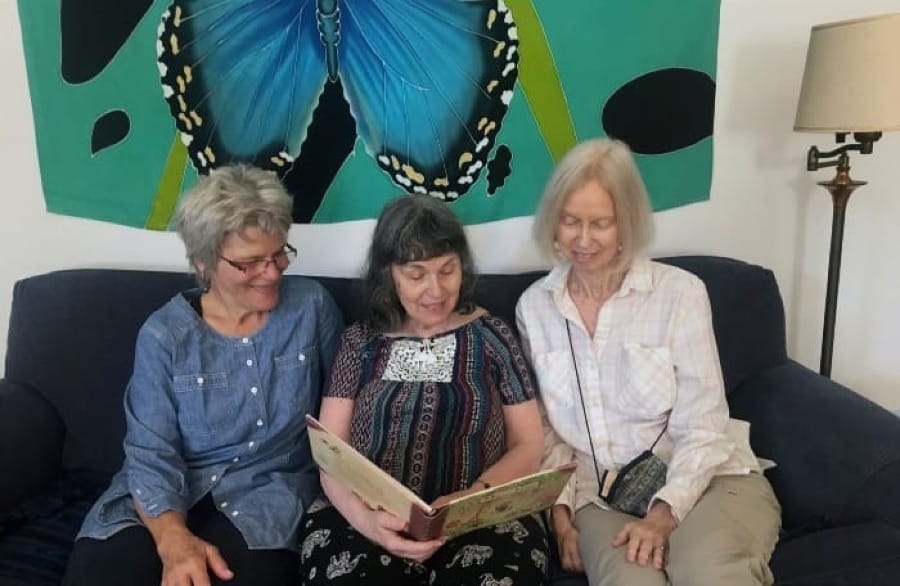
In which I share a draft of an essay about friendship, love, a cottage, and a blue couch. Written sometime in 2022. Skip to the end for a recent photo of Josie.
When I think of home, the room that appears in my mind is the kitchen of Jane and Mom’s cottage. It was a small house behind another house in the Willows neighborhood of Menlo Park. The pink cottage still has a fairytale-like quality, akin to how I imagine the homes in ‘The Wind in the Willows’ — complete with an almost mythical comforting feeling of a deep breath and a cup of tea before burrowing in for bedtime.
Mom and Jane lived briefly in the cottage with another friend Nancy, before I was born. After I went to college, they found out it had been re-done and an open house revealed it was exactly what two 60-year-old best friends needed, and they moved back in. Jane was like a second parent to me — a support system, one of the most consistent people I have ever known, a reader, an editor, and poetry appreciator.
After walking down the gravel path that crunched a little too loud, you’ll see a peppermint-pink-colored house with dark maroon trim behind the main house. From the main driveway, there’s a stone path through a small garden with a few cement fish peering out from the flowers — likely some Zinnias and daffodils as well as a few roses. The cement fish sculptures are the art of Bob Lucas, from Bainbridge Island, Washington. We used to spend our summers amidst his art workshop at another friend's home. As you walk the short stone path to the front door, you’ll see a large ceramic tile hung on the fence with what looks like two people dancing in a brightly colored sunny nature scene. You’ll also see some of my art from a college ceramic sculpture class, and a cement sun-moon-mother lady sculpture.
If no one is home, there is a hidden key. Let yourself in, but knock or call first so you don’t startle whoever is quietly cooking, reading, or crafting inside. When you walk in, there is a chair for you to sit on and take your shoes off. The chair is next to an old dresser and placed on top is a ceramic jug filled with dried orange Japanese lantern flowers. In this house, things in need of mending are sewn back together, rather than thrown away. Toilet paper rolls are saved for art projects. The value of handmade crafts was on display in the form of quilts hung on walls. Books with titles like 'Our Bodies, Ourselves' and ‘Woman’s Craft as Art,’ established a feminist bookshelf. In this house, we appreciate the antique, unique, and aged items like fine wine (though neither Mom nor Jane drank much). We value art and color, over a modern matching minimalism. A small homemade basket for your keys is on the dresser — a basket I made, alongside one purchased in Botswana during my study abroad. Every item seems to have a story.
As you enter the house, the blue couch is the central piece of furniture with a large butterfly tapestry behind it.
Two light blue chairs face the dark blue couch. Not recliners for watching TV but short chairs that make you want to cross your legs and lean into what someone is saying. There’s also a small wooden side table next to each sitting spot for resting your teacup. There’s no TV. Oh wait, yes there is, but one could easily forget that the TV lived in Mom’s room and was used primarily for movies and March Madness.
Movies that my mother watched over and over — like Mr. Holland’s Opus, and Forest Gump. March Madness didn’t just mean any college basketball, it meant Stanford basketball (specifically Stanford women's basketball). An obsession that began when Jane was a resident fellow and living in an apartment on the Stanford campus. Her home opened up into a set of dorm rooms with one door. I can still remember the feeling of opening that door to another world, and maybe this is why I love the university as a form. A door to so many more doors.
Jane started going to basketball games, and at some point took Mom along, and then they were season ticket holders for several years, including the mid-to-late 90s when they would bring me (and anyone who expressed remote interest) and the very best thing in life was going to the cafeteria with Jane and mom and then going to a basketball game. These two mostly calm and collected ladies could really yell when they got to Maples Pavilion.
I too, wanted to become one of those strong, talented and smart women — I played YMCA basketball and I played Peninsula basketball and JV basketball team and would be one of the captains of our 26-0 team sophomore year which felt like the biggest accomplishment. More importantly, I’d make friends, or maybe one particular friend that I just texted to ask a weird and silly question. And this is the same friend who, when moving out of her apartment, asked me if I wanted to move in, and the same friend that while working at Stanford, asked me if I wanted to go to go to a game and maybe bring mom and Jane? Of course I did, and they loved it. And this is the last picture I have of us three together before Jane got cancer and before mom’s quick decline from Alzheimer’s.
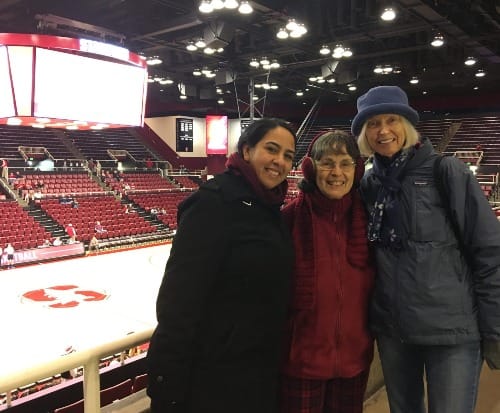
But I am telling you about the cottage, and the couch, and the wood floor that creaked near the small hallway towards the bathroom. The kind of creak that isn’t annoying but makes you aware of where the other person is. So that when waking up in my mom's room I could know that mom is home and moving around in the kitchen and from the sound of the gentle closing of a door, that Jane has just gone into the bathroom.
The refrigerator is covered in photographs and mom’s abundant (and arguably over-the-top) magnet collection. The windows are bright with sunlight and little lace curtains at the top, an almost midwestern nod to both Mom and Jane’s upbringings (Mom outside Chicago, and Jane in Indiana). And a plant or two in the kitchen window — the Christmas cactus had a central place on the small side table next to the table, often with a bouquet from the garden, or a friend's garden or the farmer’s market. Occasionally with a handwritten card next to it to celebrate a birthday or holiday, or just a sweet letter from a friend.
The electric kettle stood at the ready for tea. Mom had placed one of my clay creations on the counter — a woman form in a dress, and more recently she had placed a poem she wrote in the 80s about the crescent moon resting in front of the clay lady. There is also a crescent moon carved into the clay woman’s dress. To the right of the sink is an old radio, a bread basket and sometimes a tin with sweets — Jane’s apple cake, mom’s chocolate-chip cookies.
The variety of mugs, some handmade, some with photos or memories of trips were displayed on an open shelf just above the microwave (Which mug would you like? or Choose your mug! was a common refrain during the tea-making process. A sort of validation of one's own unique choice and desires in constant active practice). The baskets were usually filled with fruit — likely from someone’s tree nearby, or the farmer’s market. The presence of fruit bounty confirmed my mother’s adage that: “You know you’re rich when you have a full fruit basket!”
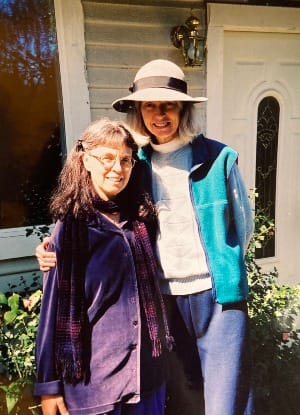
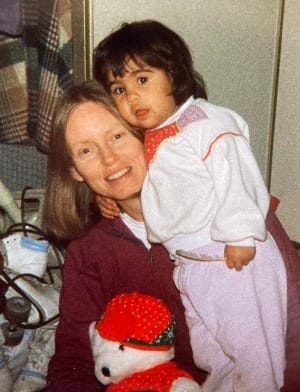
Mom and Jane in front of their cottage (2000s?), Jane and me in the 1980s.
Remembering the warmth of the kitchen — the one awkwardly short cream-colored armchair I liked to sit in, and Jane’s old rocker, the brightly colored bookshelf which still held some kid's books at knee-height. And many books of poetry. Jane led a poetry appreciation group at the local women’s center.
The kitchen felt perpetually bathed in soft light. The table could expand during holidays or dinner parties, and contract to be perfect for two or three; it was filled with an ever-present and reliable love.
Mom and Jane met through Nancy sometime in the 70s. While they lived together they both had boyfriends. And then Jane eventually married, but their love was the kind of big, real true stuff that was reaffirmed in how they treated one another. Jane lived her life as a model for how I want to live mine.
I liked cooking for them in the same way that I liked writing for them. There was reliability, an appreciation, specific feedback in the form of noticing, (“I like how you quoted that one lady,” or “The spice on the tofu is really delicious”) that subtle acknowledgment, a detailed act of paying attention and noticing.
They did a fair amount of cooking — for each other, for the potluck, cookies for the bakery, or for Kathleen, the kind of purposeful loving through open-hearted hearths. Not the ‘I’m a lady and I have to cook,’ but the alchemy found in the ‘I’m-a-talented-witch-with-recipes-passed-down-from generations-and-look-at this magic I just made!’
And when you cooked, the other person cleaned, and it wasn’t so much a rule but an obvious relationship based on an equitable division of work. And since I was 18 I observed the beauty of a relationship based on care and appreciation rather than a demand for reciprocity — a kind of give and take, a sharing that I might value above romantic love (if we’re ranking, and we probably shouldn’t be). It seems so obvious that we need more models of how to live this way with one another in the world.
They, in their simple ways, with their “Water!” post-it sitting just next to the refrigerator (so you didn’t need to write a new one every time to remind yourself the water hose for the garden was on) and the friends who would, could, and often did, walk down the gravel driveway from the street and just stopped by — provided a model for the possibility of another world.
But back to the couch, because now I am realizing (and only through writing this did it become clear) that the couch in the living room was also the site of their last meeting.
Big sis brought Mom from Arkansas and though Mom’s mind was fading she had moments of clarity. And we knocked gently on the door and came in. Jane sat on the couch, her already thin body looking like she might disappear soon. But she smiled at Mom and Mom smiled at her and they sat on the couch together and trying to remember it now, I have no idea what they said but saying wasn’t actually the point and had never been the point. Being there, and being fully in the moment was the point and there’s no need to argue or fight or try to hold something that is on its way out.
Just barely a week before Jane would no longer be living in that home, and any home except the home of too many hearts. This was the moment at the end of Ross Gay’s Catalogue of Unabashed Gratitude in which he says “goodbye, I mean to say, and thank you. Everyday.”
At her celebration of life, the way Jane lived was described as a living poem, balanced and shaped by thoughtful and joyful intention. “Poetry helps me deal with life’s losses and celebrate the joys,” she had said.
Mom and Jane's real love, friendship-love, this bell hooks female-communion-love had been modeled very well for me.
Just a few months after Jane passed in December 2019, I was back in the cottage being asked what I wanted to keep. Certain things were already accounted for — the antique furniture and items of traditional monetary value. I wanted to keep every item to be reminded of the love and friendship that existed between Mom and Jane. I placed some of the pots with the copper bottoms, the teapot shaped tea bag holders, the tile with the happy people, a rolling pin and some mugs in a box and brought them to my car. But how do you hold a feeling? The whole kitchen warm with cooking and discussions. Despite my desire to take everything that could possibly fit in my small car, I also knew the items would not come alive with Jane’s exclamations of joy and appreciation. I couldn’t save my mother from her fading memory by making soup in the same pot she and Jane used. I took what fit and left most of the rest, but even now I wish I had taken more, maybe if I had, I could’ve better recreated their kitchen in my own.
I came back another day for the blue couch. I hired movers — an adult thing to do. Maybe precisely when you have no other home to go back to, is when one becomes an adult. The movers thought I had more to move, but it was mainly just this big heavy blue couch.
For me the couch, much like the kitchen, also represented a sense of home. After work or school, on slow mornings or entertaining friends, Jane would sit on the left side of the couch with her lamp and small pile of magazines or books and mom would sit on the right side with a project or school calendar in her lap. There were no fixed spots, but habits being what they are, this is how it usually was. If I sat in mom’s spot she might sit in the middle and take my feet in hers and begin to give me an impromptu foot massage. Just a small expression of love, played out between people on the couch. My mother took many naps on that couch. Jane read many books. When my friend from Germany came to stay with us briefly, there’s a photo of mom, Jane and I on the couch — and though I love the cozyness of the blue couch, it wasn’t really about the couch but everything that happened on and around it.
The movers put the couch down in my living room and I settled it in against the wall. It fit well, and I wondered why I hadn’t bought my own couch sooner. I lay down, and in a wave of grief (or relief, or both?) fell asleep. I dreamt I was looking for my mom and I was looking for her all throughout a three-story house. I was walking along a European cobblestone path wondering where she had gone and getting frustrated, because I knew she was there, but I couldn’t find her anywhere. Finally, I climbed the stairs to the attic to find her asleep in a bed. The symbolism couldn't have been more overt to me. Even though my mom and Jane were no longer fully there, I knew they were both deep inside both my body and my brain.
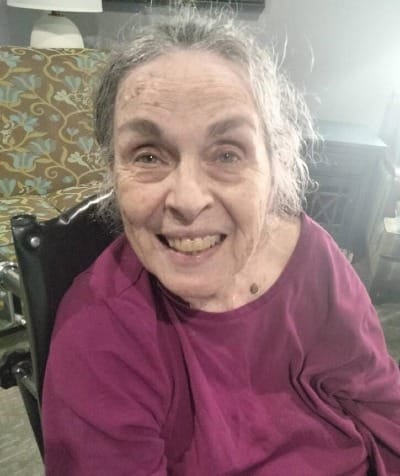
This post is part of a series of essays called Josie's House. Previous essays can be found here. This is part of a larger project I envision as a book of essays:
- New Beginning: In which I try to figure out how to tell people that the doctor at my mother's assisted living facility referred her to hospice care — meaning that based on her weight loss and decline, she is expected to be gone within six months.
- Mom Rocks: In which I attempt to introduce my mother and this project.
- 'Are You My Sister?': In which my Josie-mama thinks I am her sister and I find a letter my mother wrote to her sister after she died in my mother's arms.
- Mandala's Tiles and Poetry: In which I go looking for tiles in India and re-discover my mother's love of mandalas and some poetry-letters she wrote after my grandmother died.
- A Purple-Infused 80th Birthday: In which I marvel at the passage of time, birthdays, and garden metaphors.
